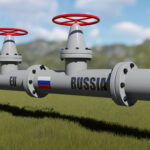(Oil & Gas 360) – Energy policy was cited as a significant reason for the growing gap in global competitiveness between the European Union (EU) and its rivals China and the United States in a 400-page report to the EU released earlier this month.
The report was submitted by Mario Draghi, who was prominent in the EU for nearly 15 years. He served as president of the European Central Bank from 2011 to 2019 and was Prime Minister of Italy from 2022 through COVID-19.
Draghi noted that innovation, industrial output, and consumer spending were falling behind the U.S. and China, mainly due to the price of energy for industry. Natural gas costs three-and-a-half times more in the EU than in the U.S.; electricity costs more than one-and-a-half times more. Nonetheless, the report continues to highlight the energy transition goals for 2050.
A prime policy example is Germany. With the largest economy in Europe, Germany also has the continent’s highest energy costs. The country’s Energiewende (“energy turnaround”) initiative aims to cut greenhouse gas emissions by over 80% by 2050 via more renewables. It also calls for reducing energy consumption by 50% by 2050 compared to 2008.
The report acknowledges the role fossil fuels will play at least through the end of this decade but cautions that decarbonization efforts will fail if the cost of providing energy from renewable sources continues to negatively impact homes, businesses, and industry on the continent.
It calls for roughly $900 million (U.S.) a year in investment to narrow its competitiveness gap through quicker adoption of new technologies, more uniform permitting and better grid capacity and reliability.
The EU has taken steps regarding its exposure to natural gas markets exacerbated by the Russian Ukraine war.
An EU collective gas procurement agreement from two years ago gives the EU better bargaining power when purchasing gas and hydrogen and better coordination for regional gas distribution.
An earlier tender, for instance, attracted bids from 25 gas suppliers, reducing dependence on Russian gas while increasing access to gas and hydrogen from the U.S., Egypt, Norway, and Azerbaijan.
By Jim Felton for oil&gas360.com








